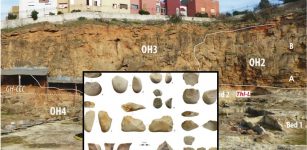Thousands Of Ancient Tools From A South African Cave Reveal Prehistoric Human Connections
Jan Bartek - AncientPages.com - In a cave with a view of the ocean on South Africa's southern coast, archaeologists have uncovered thousands of stone tools crafted by ancient humans approximately 20,000 years ago. By closely examining the minute details in the chipped edges of these blades and stones, experts can determine the methods used to create them.
Archaeologist climbing up the cliffside to the cave site. Credit: Sara Watson
A recent study published in the Journal of Paleolithic Archaeology delves into these findings, analyzing how various tool-making techniques provide insights into prehistoric human travel patterns, interactions, and knowledge exchange.
“This is an important insight into how people who lived in this region were living and hunting and responding to their environment,” says Sara Watson, a postdoctoral scientist at the Field Museum’s Negaunee Integrative Research Center and lead author of the study.
Between 24,000 and 12,000 years ago, these blades were made, and the Earth was nearing the end of the last major ice age. Since so much of the Earth’s water was frozen in glaciers and ice caps, the sea level was lower, and the region that’s now the coast of South Africa was a few miles inland.
“Instead of being right on the water like they are today, these caves would have been near vast, open plains with large game animals like antelope,” says Watson. “People hunted those animals, and to do that, they developed new tools and weapons.”
Prehistoric stone tool cores. Credit: Sara Watson
The caves, part of what archaeologists call the Robberg technocomplex, no longer overlook a plain— they're in a towering cliff face over a rocky beach. “It’s a 75-foot climb up to the cave from the shoreline,” says Watson. “We had safety ropes and a staircase made of sandbags, and we had to be harnessed in while doing the excavation.”
Each day, Watson and her team undertook the challenging task of climbing with up to 50 pounds of excavation and photography equipment. Given the ancient nature of these sites, dating back to before the end of the last ice age, meticulous care was essential during excavation. Watson explains that they employed small dental tools and mini trowels to delicately remove each layer of sediment.
Underneath layers of ancient dust, they uncovered thousands of stone tools, including small sharp blades and larger rocks known as cores from which these blades were crafted. According to Watson, while most people focus on detached pieces like blades and flakes when thinking about stone tools, it is the core that truly fascinates her. The core reveals specific methods and sequences used in tool-making.
When your average person thinks about stone tools, they probably focus on the detached pieces, the blades and flakes. But the thing that is the most interesting to me is the core, because it shows us the particular methods and order of operations that people went through in order to make their tools,” says Watson.
Archaeologists working in the cave overlooking the ocean. Credit: Sara Watson
Watson's team identified distinct patterns in how cores were reduced into smaller blades. She notes that this process often involves specific techniques learned through social transmission. Observing consistent core reduction methods across various sites suggests a sharing of ideas among people at that time.
“If we see specific methods of core reduction at multiple sites across the landscape, as an archaeologist, it tells me that these people were sharing ideas with one another,” says Watson in a press release.
For example, a particular technique for creating tiny bladelets found in Robberg caves also appears hundreds of miles away in Namibia and Lesotho. This repeated pattern indicates intentionality rather than coincidence.
See also: More Archaeology News
Watson concludes that their research highlights how much remains to be discovered about Robberg caves' history and its ancient inhabitants. She emphasizes our species' long history—extending further back than commonly realized—and notes similarities between humans living around the last ice age and those today.
Written by Jan Bartek - AncientPages.com Staff Writer























